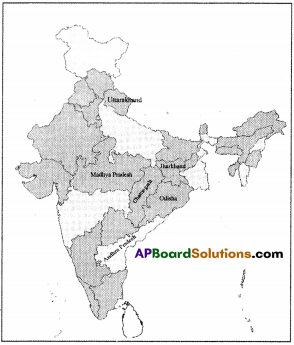These AP 9th Class Social Studies Important Questions 18th Lesson Impact of Colonialism in India will help students prepare well for the exams.
AP State Syllabus 9th Class Social 18th Lesson Important Questions and Answers Impact of Colonialism in India
9th Class Social 18th Lesson Impact of Colonialism in India 1 Mark Important Questions and Answers
Question 1.
What was the call given by Komaram Bheem to Adivasies? (SA-III : 2016-17)
Answer:
Adivasis were inspired by the message Jal, Jangal, Jameen of Komaram Bheem.
9th Class Social 18th Lesson Impact of Colonialism in India 2 Marks Important Questions and Answers
Question 1.
Mention any two reasons for deforestation during the British rule. (SA-II : 2018-19)
Answer:
The following reasons were responsible for deforestation during British rule.
- Large cities like Kolkata and Mumbai were coming up.
- The government was laying thousands of kms of railway lines across the country.
- Huge ships were also being built and mines were being opened.
- Wood is need for railway sleepers.
9th Class Social 18th Lesson Impact of Colonialism in India 4 Marks Important Questions and Answers
Question 1.
Once they began work on the machines there was no question of stopping. There was no fixed break even for meals. Taking out 15 – 20 minutes from their work, and asking a fellow labourers to look after their work, the labourers would eat their food. There was no separate place to eat either.
The whole day would pass in the heat, humidity, noise, dust and suffocation of the mill. Only when the sunset and it became impossible to see in the dark, the machines would stop and work would end.
Q. Comment on the working conditions of workers in factories in early industralisation. (SA-III : 2016-17)
Answer:
- The working conditions were terrible.
- People worked 14 to 16 hrs a day.
- Majority were unskilled workers, only receive very low wages.
- Factories were not the best places to work.
- Machines spit out smoke and in some factories, workers come out covered in black soot by the end of the day.
- Children were paid less.
- The workers were given only a break for lunch and dinner.
- Many children had physical deformities because of the lack of exercise and sunlight.
9th Class Social 18th Lesson Impact of Colonialism in India Important Questions and Answers
Question 1.
Read the following information and answer the questions given below.
The government implemented the first Factory Act in 1881 and made the following rules especially for the welfare of working children:
Children’s working hours were reduced from 9 to 7 hours/day and factory employers were forbidden to employ children below 9 years of age. The largest number of labourers in industries was that of men. In wasn’t until 1911 that laws for their welfare were made. According to the Factory Act of 1911:
|
a) When was the first factory act passed and what did it specify?
Answer:
- The first factory act was passed in 1881.
- It specified that children below 7 years cannot be employed in factories and the children cannot work more than 9 hours.
b) When were the interests of women ensured?
Answer:
In 1891, laws were made in the interest of women labourers.
The women labours working hours were limited to 11 hours.
c) Who were the largest number of labourers in industries?
Answer:
The men were the largest number of labourers in the industries.
d) How many factory acts were passed ? And when were they passed?
Answer:
Three acts were passed :
- In 1881
- In 1891 and
- In 1911.
Question 2.
Read the following passage and answer the questions given below.
’ During strikes labourers formed their own organisations with the help of some educated people. These were labour unions, formed to conduct the strikes and negotiate settlements with the mill owners. Slowly, the trade unions became active not just during the strikes but all around the year, promoting the workers’ welfare and rights. Such unions began to be established from the early 1920’s. People influenced by socialist thought were prominent among them. One such union formed was Girni Kamgar Union with the help of which workers in Mumbai went on a very effective strike in 1928. In Ahmedabad, under the influence of Gandhiji, a powerful union known as the Mazdoor Mahajan was formed.
a) Why were the labour unions formed?
Answer:
Labour unions were formed to conduct the strikes and negotiate settlements with the mill owners.
b) Who helped the labourers to form unions?
Answer:
Educated people helped them.
![]()
Question 3.
Observe the following table and answer the questions given below.
| Year | Event |
| 1879 | 8000 kilometers of railway lines |
| 1864 | A forest department was set up. |
| 1856 | The Santhal adivasis revolt |
| 1880 | The Koya adivasis revolt. |
| 1910 | The Maria and Muria adivasis revolt |
| 1940 | The Gond and Kolam adivasis revolt |
| 1914-18 | 1st World War |
| 1919 | Strike of all the mills of Mumbai |
a) What was the importance of 1919?
Answer:
All the mills of Mumbai were kept closed for 12 days due to the strike of workers.
b) When did the adivasis of the Maria and Muria revolt?
Answer:
The Maria and Muria adivasis revolted against the forest department in 1910.
c) When did the Santhais revolt?
Answer:
The Santhais revolted in 1856.
d) Who revolted in 1940?
Answer:
The Gond and Kolam revolted in 1940.
e) When did the 1st World War occur?
Answer:
Between 1914-18, the 1st World War occurred.
![]()
Question 4.
Find out where each of these adivasi struggles took place, and mark their locations on a map of India.
Answer:
Adivasi struggles took place in the following locations.
- Madhya Pradesh
- Chattisgarh
- A.P
- Odisha
- Jarkhand
- Uttarakhand

